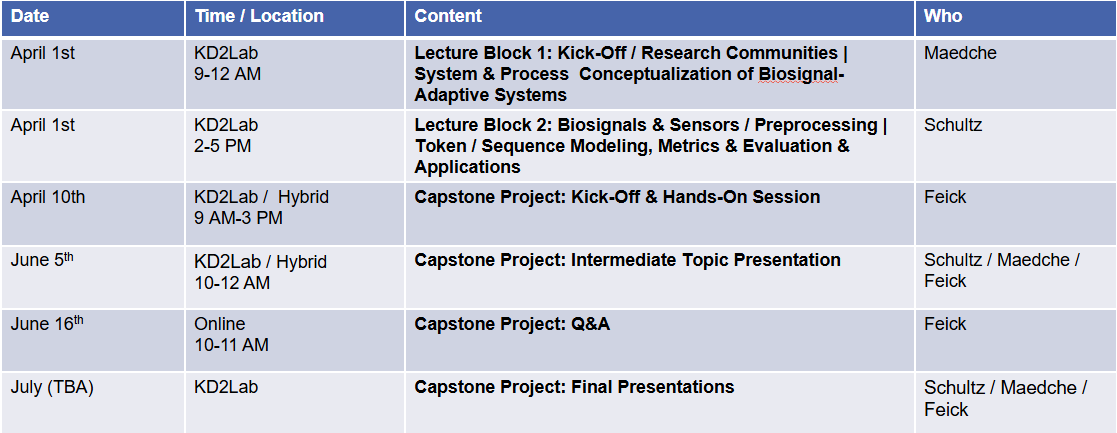Biosignal-Adaptive Systems Design
- Type: Lecture (V)
- Semester: SS 2025
-
Lecturer:
Prof. Dr. Alexander Mädche, Prof. Dr. Tanja Schultz, Martin Feick
- SWS: 2
- Lv-No.: 2500038
-
Information:
maximum #students: 16
Overview
This course introduces existing adaptive systems research in selected research communities and describes important concepts. Furthermore, we articulate major building blocks of biosignal-adaptive systems and describe design/evaluation processes and activities. We classify different types of biosignals and describe key procedures for measuring, processing, classification, and interpretation. Finally, participants collect, process and analyze biosignals and design an adaptive systems prototype as part of the capstone project. It is offered as part of the DFG-funded graduate school “KD2School: Designing Adaptive Systems for Economic Decisions“ (https://kd2school.info/)
Registration
You can register for the Biosignal-Adaptive Systems Design course by sending an e-mail to office-ise∂iism.kit.edu with the following information:
- name
- university
- project preference; priority 1, 2 and 3 (details below; Teams of 4-5; first come, first serve basis)
Course objectives
Students will be able to:
- explain existing adaptive systems research in selected research communities and describe important concepts
- articulate major building blocks of biosignal-based adaptive systems and describe design/evaluation processes and activities
- classify different types of biosignals and know key procedures for measuring, processing, classification, and interpretation
- Collect, process and analyze biosignals and design an adaptive systems prototype as part of the capstone project
Schedule

Capstone projects
1. Mental Load-Adaptive Meditation
The objective of this project is to utilize heart rate (HR) / heart rate variability (HRV) and prompt an LLM to generate a personalized meditation experience tailored to the user’s current mental load. The system should be designed to not only initiate meditation based on HR/HRV parameters but also to adapt the meditation experience, responding to the user's actual experience (i.e., changes in mental load) during meditation to promote relaxation and well-being. In the context of this course, it is sufficient to focus on binary adaption, i.e., based on high and low mental load.
2. Stress-Adaptive To-Do List
This project aims to develop a stress-adaptive to-do list for office workers that dynamically reorders tasks based on real-time heart rate (HR) / heart rate variability (HRV) measurements. The system continuously monitors physiological (HR/HRV) indicators of stress, enabling real-time adjustments for task prioritization. The to-do list consists of two task categories, demanding and simple tasks. In high stress situations, the system prioritizes simple tasks to ensure that users tackle cognitively easy work when they are in a stressed state. At the start, the system determines a personalized baseline and a stress threshold for each user, which are then used to distinguish between high and low stress levels.
3. Flow-Adaptive Immersion
The goal of this project is to develop a flow-adaptive immersion system to promote maintaining in a high state of flow. The system dynamically transitions from Mixed Reality to fully immersive Virtual Reality and vice versa, based on heart rate (HR) / heart rate variability (HRV) measurements. The system continuously monitors physiological indicators of flow, blocking distracting visual cues that may disrupt task flow. Initially, the system determines a personalized baseline for each user and with increasing task flow seamlessly adapts the level of immersion. For the project, it is sufficient to distinguish between high and low levels of flow.
Additional
- maximum #participants = 16
- course hardware: Polar H10 chest strap
- basic programming skills in Python are necessary

